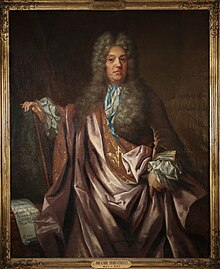| Johan Gabriel Sparwenfeld | |
|---|---|
 Johan Gabriel Sparwenfeld, portrait by Johan Gabriel Sparwenfeld, portrait byLucas von Breda (1722). | |
| Born | 17 July 1655 Åmål, Sweden |
| Died | 2 June 1727 Åbylund, Sweden |
| Noble family | Sparwenfeld |
| Occupation | Linguist Master of ceremonies Diplomat Diarist |
Johan Gabriel Sparwenfeld (Latin: Ioannes Gabriel Sparvenfeldius; (17 July, 1655 – 2 June, 1727) was a 17th-century Swedish diplomat, linguist, polyglot and diarist.
Biography
Johan Gabriel Sparwenfeld was born to Johan Sparwenfeld (1618–1698) and Christina Uggla. Sparwenfeld began his studies at the age of eight in Uppsala. Some researchers believe that he studied law, history and languages. And after he had finished studying Sparwenfeld went to search for old Swedish manuscripts in The Netherlands, France and Italy.
In 1674, he was brought by his uncle, amiral Claes Uggla, on a voyage to the Duchy of Holstein. And during the Scanian War (1675–1679) he was captured and brought to England when a Danish corsair caused the ship to sink. It was not until three years later that he was given permission to return to Sweden.
In 1684, Sparwenfeld was sent to the Swedish embassy in Moscow. It was during this time that he wrote his diary portraying life and culture in Russia. During his visit to Russia, Sparwenfeld became interested in Slavic languages, he began to learn Russian and did so really well. He later started with lexicographical studies in Slavic languages and held on to that work for almost 20 years. His work later made him publish the Lexicon Slavonicum.
Sparwenfeld had a strong interest in Arabic. He is known to have acquired the Barthélémy d'Herbelots Bibliothéque Ori-entale in 1697 from Paris. In which several notes had been made by him showing his interest and knowledge in Arabic. Sparwenfeld had a special interest in Syrian Arabic.
Sparwenfeld is known to have been able to speak 14 languages. Including Spanish, Arabic, Latin, Russian and Greek.
Personal life
Sparwenfeld married Antoinetta Sophia Hildebrand in 1695. In the following eight years, Sparwenfeld and Hildebrand had a total of eight children.
In popular culture
In September 2020 Sparwenfeld and his estate Åbylund in the parish of Romfartuna in Sweden were depicted in the SVT-series Det sitter I väggarna.
Publications
- Lexicon Slavonicum
- J.G. Sparwenfeld's diary of a journey to Russia (1684–1687)
- Sparwenfeld's Map of Siberia
References
- Kritikon litterarum (in German). Vol. 13. 1989. Retrieved 2009-10-10.
- Johan Gabriel Sparwenfeld (2002). J.G. Sparwenfeld's diary of a journey to Russia 1684-87. ISBN 9789174023244.
- Tarkiainen, Kari (2019-03-14). "När terrorn slog till i Stockholms skärgård". Svenska Dagbladet (in Swedish). ISSN 1101-2412. Retrieved 2020-11-12.
- ^ "Johan Gabriel Sparwenfeld". sok.riksarkivet.se. Retrieved 2020-11-12.
- S, G. A. (1853). Förteckning öfver porträtt- och taflesamlingen på Gripsholms Kongl. Lustslott, upprättad af G. A. S[turnegk] (in Swedish).
- Det sitter i väggarna - Säteriet Åbylund, Västmanland (in Swedish). Retrieved 15 October 2020.
External links
- [REDACTED] Media related to Johan Gabriel Sparfwenfeldt at Wikimedia Commons
| Honorary titles | ||
|---|---|---|
| Preceded by | Master of ceremonies to the King of Sweden 1701–1712 |
Succeeded by |